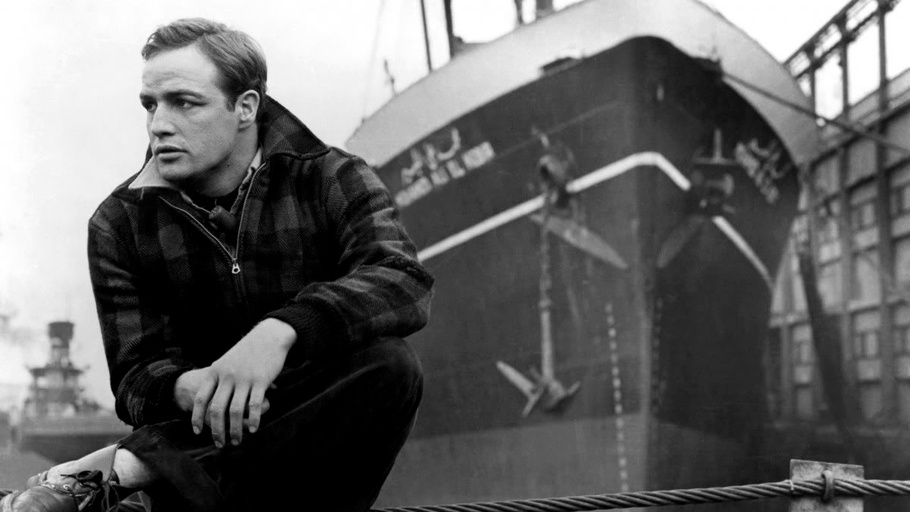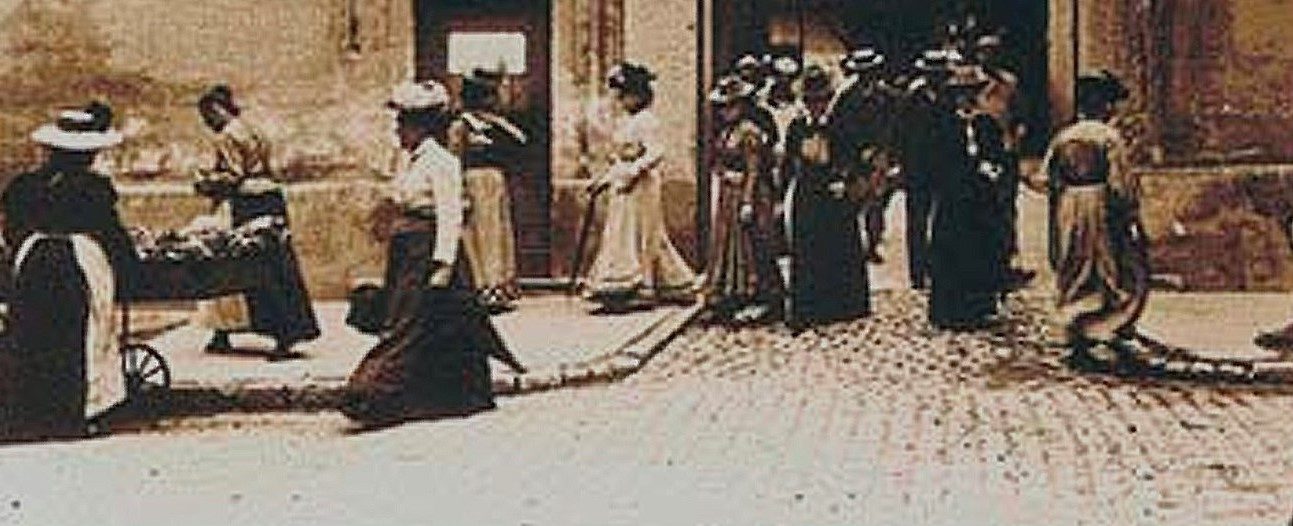United States, 1954
Directed by Elia Kazan
With Marlon Brando (Terry Malloy), Rod Steiger (Charlie Malloy), Lee J. Cobb (Johnny Friendly), Eve Marie Saint (Edie Doyle), John F. Hamilton (“Pop” Doyle), Karl Malden (Father Barry)

The opening is a nocturnal, brutal, fast-paced, and highly dramatic exposition introducing the lead character, the story’s good people, and what is at stake for them. The powerful series of shots track how Terry Malloy was duped into laying a trap for a friend of his who had been summoned to testify on the shady inner workings of the trade union both are members of as longshoremen in New York. The guy is cold-bloodedly murdered; around his body gather his father, “Pop” Doyle, his sister, Edie Doyle, the local Catholic priest, Father Barry, and a policeman. Edie cries for justice but nobody seems ready to answer the policeman’s questions.
The story’s bad people appear in the second sequence when Terry goes to a watering hole which is the dingy meeting place of the union. Under the harsh lights of the backroom Johnny Friendly, the union’s boss, talks business, swaggers, and bullies. He makes plain two things: the dubious interests of his group are paramount (so even murder is fine) and Terry is to his liking, opinions that please his accountant, who is none other than Terry’s brother, Charlie Malloy. But Terry remains uncomfortable.
The film is the poignant chronicle of the long and difficult change of heart of Terry, a tortured move from supporting corrupt unionists to defending honest workers, from dismissing law and order to standing for truth and justice, from being a lone and dull figure to caring for another one’s feelings. This personal journey has an obvious redemptive quality and the finale is akin to a resurrection.
This change owes a lot to a religious personality, the priest which readily stands at the side of the first victim of Johnny Friendly’s tyranny, Father Barry. Shocked by the unfairness and cruelty of the longshoremen’s union, he attempts to mobilize some workers during a meeting in his church. But the participants are attacked and chased away by Friendly’s thugs. During the brawl Terry rescues Edie, avoiding her from being hurt and allowing him to strike up a relationship with her. Edie looks swiftly like Terry’s best chance to escape solitude and get out of his morass (Edie is nice-looking and remarkably gentle and she is training to be a teacher) but the murder of her brother makes it difficult for her to embrace him without asking for justice once again and forever.
This call for justice prods later Father Barry into giving an impassioned sermon after he gave the last rites to a decent and outspoken worker killed by a sabotage act inside a ship. Despite the heckling of the usual thugs, he carries on unfazed and his fiery rhetoric does upset Terry. So much in fact that he decides to tell the truth about the previous crime to the priest and, following the priest’s bidding order, to Edie. This makes for a dramatic and poignant scene as the fear of losing the girl drives Terry to break with his former acolytes, despite his brother’s last minute plea (Charlie’s failure to talk his brother out of speaking out leads to his assassination).
This dialogue between the brothers yields interesting information casting Terry’s story into another light. It becomes clear his past career in boxing was deliberately spoiled by rigged fixtures organized by Charlie; he has been reduced to the role of a dumb and dependent manual worker when he could have a chance to build his own life. The struggle sparked by the moral pressure Father Barry and Edie is also a fight to find back relevance to his life and to assert his place among the society of men. The final images perfectly illustrate his hard-won success, as he does rise from the ground after taking a severe beating at the hands of Friendly (like others would rise from the dead), and, heavily bruised and limping, he struggles to walk on and lead the longshoremen to the warehouse where they should work. He barely makes it while a mad Friendly yells threats but the men carefully step back to let him go. In broad daylight the workers then enter the place whose gates are right away closed; a new day of work has started and a new world can also start.
The deeply religious undercurrent of the narrative is a powerfully symbolic but convenient device to dramatize a story dealing with a sensitive political topic and a moving portrait of alienation. “On the Waterfront” is a concerned movie, focusing on working-class people, struggle for money and dignity, and ill-starred destiny. It depicts the shocking mixing of mob mentality and narrow-minded trade unionism as precisely and graphically as possible and gives a candid vision of the dire material conditions of the port’s neighborhood; what those lives boxed in these little cages to live and to work becomes a concrete experience for the audience. This unremitting focus does not call for nuances but indeed properly exerts the strongest effect to gather a deeply unfair situation and to confront it.
The first face-to-face conversation between Terry and Edie in a bar is a simple but clever and forceful series of shots and reverse shots taken in close-ups; the delicate performances of the actress and even more of the actor are riveting and fully convey the fragile and tentative relation their characters try to build at this point. It is deeply moving and captures the terrible hardship blighting Terry’s life and the ever more terrible effort he must make to improve his life. The pigeons he takes care of on the roof of his apartment building are his sole companions and the only beings he knows how to take care of; he is an uneducated and unlucky guy both poverty and greed have cast as a constant loser and a definitive dullard. Actor Marlon Brando shows an awesome flair to express the unassuming and frustrated traits of Terry Malloy and to display his change as a genuinely harrowing personal fight.
With a screenplay by Budd Schulberg, a strong personality and a member of the Communist Party, Elia Kazan had the kind of story he relished, allowing him to delve forcefully into high individual emotions but also broader issues. His skillful, demanding handling of the cast and his quest for the most striking, dramatic, effective camera angle (informed by the noir tropes) shape a perfect receptacle to the powerful words of Schulberg and the ideas and feelings they carried.

